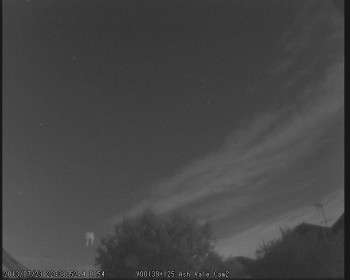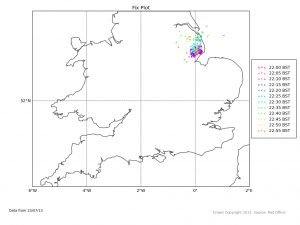Citizen scientist detects Britain's first 'lightning into space'

History was made last night when citizen scientists detected Britain's first example of a lightning strike into space.
When Richard Kacerek skimmed through his video recordings during breakfast this morning he could not believe what he saw. During last night's lightning storm he'd captured a photo showing lightning into space in the middle of the sky.
Richard recently set up several meteor observing cameras along the southern coast of England, aimed at detecting meteor showers as part of the UK Meteor Observing Network (UKMON). The cameras have been operated by citizen scientists – amateur or non-professional scientists who conduct valuable scientific activities.
Lightning strikes into space are widely referred to as 'sprites'. These are large-scale electrical discharges that take place high above thunderstorm clouds, and cause a varied range of visual shapes and flickering in the night sky.
Sprites have never been recorded in the UK, so the one detected by Richard has caused a great deal of excitement among scientists.
Dr Martin Fullekrug from the University of Bath is an expert in the electrodynamic properties of the atmosphere and has carried out a number of studies on sprites. He said: "This particular sprite is a rare example of sprites that can occur over the northern sea. The lightning flash inside the thunderstorm which caused the sprite above the cloud was also very unique."

He goes on to explain: "The sprite was caused by an upward lightning discharge which was comparatively weak, possibly because it was over the sea. The sprite occurred approximately 8.4km east of Mappleton on the Yorkshire coast near Hull."
The UK Met Office recorded the thunderstorm using the ATDnet lightning detection network which is ordinarily used for real time forecasts of flash floods, hail, and wind gusts often associated with thunderstorms.
Graeme Anderson, Foundation Scientist for the UK Met Office, said: "The ATDnet lightning location system operated by the Met Office picked up widespread and particularly intense storms across the UK during Tuesday 23rd July. The storms detected in the region near Hull developed around the wash before moving northwards, but were of only moderate intensity and were small compared with some other storms that occurred on that day in other areas."
Alec Bennett who develops novel lightning detectors for BIRAL, a Bristol based company, suspected sprites to happen during thunderstorms approaching the UK from the Atlantic with his new electrical sensors. He agrees that the citizen scientist team was very fortunate to catch this extremely rare phenomenon on camera.
Dr Fullekrug said: "Citizen scientists can play a major role in unravelling the mysteries of lightning into space. It is well known that upward lightning is a necessary condition to initiate lightning into space, but upward lightning alone is not sufficient.
"There are yet unknown factors which will be investigated in more detail during two upcoming space missions due to be carried out by the French and European Space Agency in 2015.
"Citizen scientists can make a major contribution by reporting sprite occurrence times, a method which has been pioneered by Richard and his meteor observing friends in collaboration with the University of Bath."
Provided by University of Bath




















